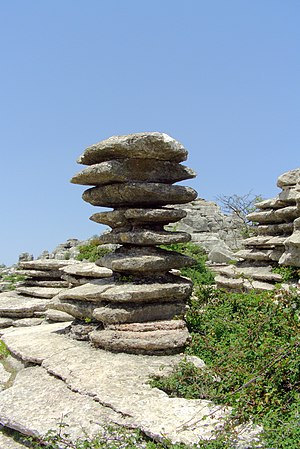Flat cart
Flat carts are first-order cart structures . They arise in karst areas due to solution weathering on the layer surface .
history
The sediment structure flat truck (mostly used in the plural form), sometimes referred to as bedding planes cart or carts table designated English clint , has been known since the 19th century. Their extensive scientific processing goes back to Smith & Albritton (1941). Significant work on flat carts with good illustrations is by Sweeting (1966 and 1972), Williams (1966) and Purdy (1974).
description

Flat carts are characterized by their flat surface parallel to the stratification. They can be found on individual boulders that are bordered on all sides in their vertical dimension by gaps or fractures. The originally only very narrow boundary surfaces (down to the thickness of a hairline crack) have been widened over time by the weathering of the solution and can in turn be designed as cleft carts . Depending on the layout of the fracture or fracture system, the individual blocks have a square, rectangular or diamond shape. The size of the individual blocks can fluctuate between decimeters and several meters depending on the prevailing lithology, but remains relatively constant at a particular location. Similar to paving stones, these individual blocks in limestone or dolomites combine to form a regular pavement.
The surface of the individual blocks does not always have to be completely flat; it can also be slightly curved upwards, as Smith & Albritton noticed in 1941. The edge is slightly raised, but is usually broken through in several places.
The surface of flat carts is usually overlaid with second order cart structures, usually round carts . However, this does not have to be the case, occasionally the surfaces are only littered with bowl carts (English pitting). In flat carts in the Alps and in the Hellenides , quite coarse bowls are usually found, which are formed in dolomite rocks as so-called pock marks.
Emergence

Today it is considered certain that flat carts are created by chemical leaching in combination with purely mechanical, hydrodynamic flow processes. It is doubted that the surfaces are only bound by stratification discontinuities, namely that they can also originate from erosion surfaces (for example abrasion plains created by glaciers - glaciated pavements) that do not necessarily have to run parallel to the stratification. Furthermore, it is not always possible to decide whether flat carts were exposed and exposed to atmospheric weathering, or whether they developed under soil or moraine cover. Both are possible. Flat carts littered with bowls were clearly the result of the effects of rain , hail and snow , but often only after a protective layer of glacier debris had been removed. Flat carts covered with round carts are ambiguous, but a majority of researchers today prefer their creation under a protective layer of soil or peat .
Occurrence
The occurrence of flat carts is worldwide.
Good examples of flat carts are found in Carboniferous limestone at Arainn and the Burren in Ireland, and at Gaitbarrows in Lancashire and at Malham Tarn in the Yorkshire Dales ; in younger rocks on Triglav in Slovenia and in El Torcal de Antequera in Spain .
literature
- John RL Allen: Sedimentary structures. Their character and physical basis (= Developments in Sedimentology. Vol. 30). Unabridged one-volume edition. Elsevier, Amsterdam a. a. 1984, ISBN 0-444-42232-3 .
Individual evidence
- ^ Joe Fred Smith, Claude Carroll Albritton: Solution Effects on Limestone as a Function of Slope. In: Geological Society of America Bulletin. Vol. 52, No. 1, January 1941, ISSN 0016-7606 , pp. 61-78.
- ^ Marjorie M. Sweeting: Karst Landforms. Macmillan, London 1972, ISBN 0-333-01165-1 .
- ↑ EG Purdy: Reef Configurations: Cause and Effect. In: Leo F. Laporte: Reefs in Time and Space. Selected Examples from the Recent and Ancient (= Society of Economic Paleontologists and Mineralogists. Special Publication 18, ZDB -ID 980588-6 ). Society of Economic Paleontologists and Mineralogists, Tulsa 1974, pp. 9-76.
- ↑ Helen S. Goldie: Limestone Pavements of Craven (Yorkshire). In: Transactions of the Cave Research Group of Great Britain. Vol. 15, No. 3, 1973, ISSN 0069-1305 , pp. 175-189.
- ^ Paul W. Williams: Limestone Pavements with Special Reference to Western Ireland. In: Transactions of the Institute of British Geographers. No. 40, 1966, ISSN 0020-2754 , pp. 155-172.
- ^ E. Schunke: On the problem of the layered karst in North Pindus, Greece. In: Marjorie Sweeting, Karl-Heinz Pfeffer (Ed.): Karst processes (= Journal for Geomorphology. Supplement vol. 26). Borntraeger, Berlin 1976, ISBN 3-443-21026-0 , pp. 65-78.
- ↑ RW Packer: Lag mound features on a dolostone pavement. In: The Canadian Geographer. Vol 9, No. 3, 1965,.. ISSN 0008-3658 , pages 138-143, DOI: 10.1111 / j.1541-0064.1965.tb00821.x .
- ^ Antony Clive Waltham (ed.): The Limestones and Caves of North-West England . David & Charles for The British Cave Research Association, Newton Abbot 1974, ISBN 0-7153-6181-3 , pp. 46-78 .